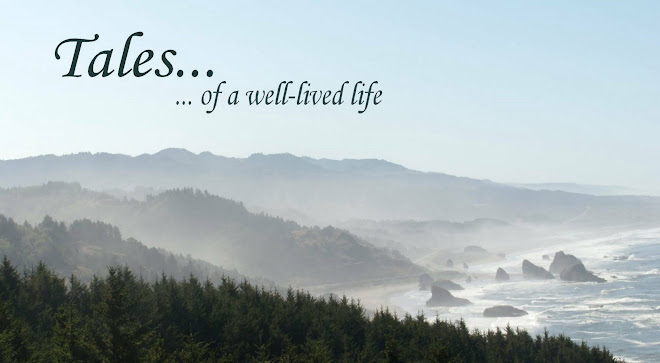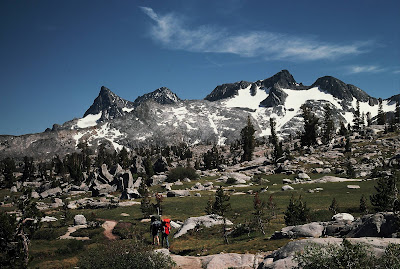On the other end of the phone was a friend from the St. Francis Yacht Club, which in itself surprised me as I don’t think he’d ever called in all the years I’d known him. “Kitty,” he said, “how’d you like to go on a 10-day backpack in Yosemite?” I pointed out to him that I’d never been backpacking in my life but sure, why not! He went on to tell me that he’d supply everything, all I’d need to bring was clothes, hiking boots and any personal items I might need, also that a third person would be with us, a 16-year-old girl who was a neighbor of his. Then he dropped the ringer: “We’re leaving tonight.” Whew! Well, OK. Why not? A few days into the hike I figured out that another woman had probably cancelled on him at the last moment and he needed a chaperone, and I had a good laugh. The hike itself had been planned for months.
I rushed out and bought some hiking boots and socks, put together everything I thought I’d need in the way of clothes and toiletries and of course, my camera and lots of film. Jeffrey picked me up late that evening and off we went, arriving somewhere near Tuolumne Meadows a few hours later where we tumbled out onto the side of the parking area to try and catch a little sleep. Late the following morning, after a lengthy time spent loading all three packs, divvying up the gear and food, we set off up the Tuolumne River through Lyell Canyon. Thankfully, this canyon is long and mostly flat and therefore easier on my body than it might have been.
Nevertheless, before that day was over I fervently wished I were home. Blisters quickly appeared from the new boots, I didn’t like carrying the pack even though it was merely a large day-pack rather than a real backpack, and there was no way in hell I could keep up with my companions. Jeffrey had backpacked all his life, often in spectacular regions of the world, and even the teenager had lots of trail miles under her belt. They kept telling me to keep my own pace, that we’d meet up further along the trail. I was frustrated and unhappy, but kept most of it to myself. There was no way I’d ruin their vacation by wanting to go back home, so I learned to grin and bear it. I remember stopping for lunch and dangling my bare feet in the cold river to ease the pain. In those days, we drank water from the river just as it was, never treated it and it was wonderfully pure and delicious.
Our goal for the day was Mt. Lyell, about 10 miles up the trail. At 13,114 feet, Lyell is the highest point in Yosemite National Park. My companions had planned to stop at several points along the trail and spend a day climbing one mountain or another. Lyell was the first of these. By now, my body and feet were all screaming but we had a good evening and set off early the next morning, up the mountain. The terrain here was an uneven minefield of huge, smooth, rounded boulders and I was really uncomfortable hopping from one to another. After about an hour, I told the others to go on ahead and I returned to camp alone, quite content to give my body and feet a good rest.
By the next day, I felt much better and while I still lagged behind the others as we climbed up and over Donahue Pass (11,056 feet), I was thoroughly enchanted with the spectacular scenery. Beyond Donahue, the trail leveled off once more through a beautiful alpine meadow and we could see the Ritter Range with Mts. Ritter and Banner, ahead far in the distance. My memory no longer tells me whether we reached Thousand Island Lakes and the base of Mt. Banner that night or the next day, but this was the next planned two-night stop.
At the base of Banner we made camp along a little stream and my companions headed up the mountain the following morning. This time, I didn’t even try to go with them. Mountain climbing wasn’t my thing, I guess. Instead, I explored the area, took a little naked sunbath (rudely interrupted by a little chipmunk who nibbled on one of my toes), and generally relaxed. The afternoon passed and as it grew later with no signs of my companions, I began to worry. All I had to eat was trail mix and I didn’t know how to work the little stove. The evening chill set in, darkness fell and I eventually retired into the tent for lack of anything better to do and for warmth. All sorts of visions of one or another of them dead or injured on the mountain passed through my brain. What would I do if they didn’t return? By morning, I’d have to abandon camp and hike out to civilization to get help – I had maps and decided that the closest point back to civilization was ahead rather than behind. Not surprisingly, I was gripped with more than a little fear – mostly for the fate of my friends, also because I was in the middle of damned nowhere all alone with no experience in wilderness. Long after dark I heard cheery voices call out and greeted their safe return with much relief. Turns out they’d encountered some women camped up the river and had stopped by their fire for quite awhile to visit and have something warm to drink. I could have killed them!
Much of the rest of the trip was uneventful and specifics fade from memory. The hiking grew easier for me as the days passed. I never learned to enjoy hopping those huge boulders (encountered when we strayed off the trail) but the scenery was indescribably beautiful, the weather warm and sunny. Wildflowers of all descriptions blazed with color everywhere we walked. By the end of the trip, I was fully hooked and have never stopped my explorations into nature, whether backpacking, day-hiking, bicycle touring or even a jeep trip deep into rutted forest service roads in Idaho. Nature warms and envelops and welcomes me every time. It’s where I feel most at home.
Of course, I was also thankful that I’d made myself continue after that first day of hiking when I wanted nothing more than to go home. I never mentioned that to Jeffrey until the last day, when the two of us hiked alone up to Iceberg Lake. “Why didn’t you say anything?” he asked.
I am so glad I didn’t!










